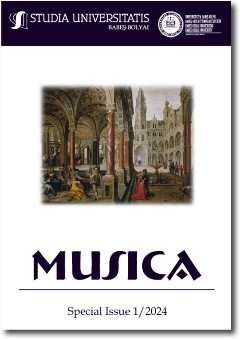A Multilevel Analysis of Fazil Say’s Sonata for Violin and Piano Op.7
DOI:
https://doi.org/10.24193/subbmusica.2024.spiss1.17Keywords:
Fazıl Say, Sonata op. 7, violin, piano, Turkish culture, composition, musical elements, modal approaches, folk traditions, dance rhythms, interpretation, structure, thematic connections, melancholy, Turkish instruments, rhythmic patterns, Horon dance, folk songs, tradition, innovation, interpretive freedomAbstract
This article introduces Fazıl Say’s Sonata for Violin and Piano op. 7, composed in 1997, shortly after his international success. Despite being an early work, it exhibits the architectural complexity characteristic of Say’s style, blending his Turkish cultural heritage with innovative compositional techniques. The authors aim to analyze this sonata thoroughly, exploring its mature style and cultural influences in order to provide a series of guiding principles for interpretation. They discuss the architectural and semantic meanings that reside in the incorporation of Turkish musical elements, such as modal approaches, folk traditions, and dance rhythms, throughout the sonata’s three movements. Each movement is examined, highlighting technical challenges, interpretive nuances, and thematic connections to Turkish culture. The sonata’s structure, culminating in a palindromic arrangement, is investigated, emphasizing its coherence and narrative thread. The first movement introduces melancholic themes, the second movement evokes Turkish instruments and rhythmic patterns, the third movement emulates the Horon dance, and the second to last movement draws from Turkish folk songs. The conclusion praises Say’s fusion of tradition and innovation, highlighting the interpretive freedom left to performers and listeners. Overall, the Sonata op. 7 reflects Say’s distinctive musical language and showcases his prowess as both a pianist and composer, blending tradition with modernity in a captivating manner.
References
During, J. et al. Kamāncheh. In: L. Libin, ed. The Grove Dictionary of Musical Instruments. 2nd Edition ed. Oxford University Press, New York, 2014, pp. 105-106.
Ertek, S. Turkish Rhythms for Drumset and Kudüm. Marzling: Leu-Verlag.
Farraj, J. & Shumays, S. A., Inside Arabic Music: Arabic Maqam Performance and Theory in the 20th Century , Oxford University Press, Oxford, New York, 2019.
Poché, C. ʺŪdʺ. In: L. Libin, ed. The Grove Dictionary of Musical Instruments. 2nd Edition ed. Oxford University Press, New York, 2014, pp. 128-133.
Poché, C., Qānūn. In: L. Libin, ed. The Grove Dictionary of Musical Instruments. 2nd Edition, Ed. Oxford University Press, New York, 2014, pp. 188-190.
Saygun, A. A., Des Danses D’anatolie et de Leur Caractère Rituel. Journal of the International Folk Music Council, Volume 2, 1950, pp. 10-14.
Web sources
Say, Fazil. Sonata for Violin and Piano. Mainz: Schott Music. 2007.
Say, Fazil .n.d. Biography. [Online] Available at: https://fazilsay.com/biography/ [Accessed 10 March 2024].
Downloads
Published
How to Cite
Issue
Section
License
Copyright (c) 2024 Studia Universitatis Babeș-Bolyai Musica

This work is licensed under a Creative Commons Attribution-NonCommercial-NoDerivatives 4.0 International License.






